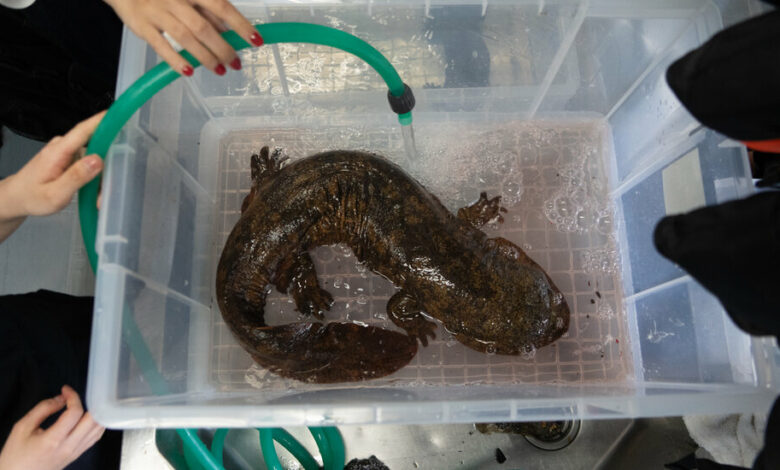A tale of two nearly extinct giant salamanders

If you are very lucky, in Japanese rivers you can come across unusual amphibians that can grow up to one and a half meters in length and resemble strange cartoon dinosaurs. They are gigantic salamanders.
“Salamanders are big and cool,” says Sena Ishikawa, a master’s student studying animals at Kyoto University. “I just love them.”
Such a passion for the slippery species, which Japan has designated a “special national treasure”, prompted Ms. Ishikawa and two other students to set out along Kyoto’s Kamo River on an unusually cold evening in March, wearing headlamps, waterproof overalls, knee-high rubber boots and neon yellow safety vests, and with what looked like oversized butterfly nets.
The three students didn’t just want to catch a large salamander: their goal was to find a purebred Japanese giant salamander.
For those who know where to look, giant salamanders are not hard to find in Japan. But they are usually not the large amphibians native to the country. The unplanned introduction of giant salamanders from China in recent decades has resulted in a growing number of hybridized animals of Japanese and Chinese origin. These mixed animals have become a bane for Japanese conservationists who want to protect the genetic integrity of their endemic species, which is considered vulnerable to extinction.
There is no good estimate of how many purebred Japanese giant salamanders remain in the wild, but the species is losing ground, said Kanto Nishikawa, a herpetologist at Kyoto University who runs the lab where Ms. Ishikawa and colleagues conduct research. “Some rivers are now full of hybrids,” he said.
Along the Kamo River, Ms. Ishikawa clambered down the steep bank and stepped into the clear, icy water. She and the other students expertly scanned the edges of the vegetation for the spotted, bulbous faces of salamanders that might be hidden among the smooth rocks. Within five minutes they found their target: a two-foot salamander that, with some gentle prodding, swam straight into their net.
Would it turn out to be a Japanese salamander, or yet another hybrid? Mrs. Ishikawa hoped for the ‘treasure’ native species, but they had to return it to Dr. Nishikawa to find out.
From salamander farm to plate
While Japan’s often elusive giant salamander species is threatened with extinction, the country can ironically help China conserve some of its giant salamanders, which face very different problems.
Unlike Japan, which has a single species of giant salamander, China has several species. But they have nearly disappeared from the wild due to poaching and habitat loss.
Dr. Nishikawa and his colleagues reported in this year’s Scientific Reports that they had discovered two purebred South China giant salamanders — a critically endangered species that can grow to nearly six feet long — living in aquariums in Japan. That means salamanders that are considered invasive species in Japan could potentially help spur the species’ return to China.
“We want to use these individuals to save the species from extinction,” Dr. Nishikawa said. “Time is running out.”
Giant salamanders are considered “living fossils” that have survived in East Asia for about 170 million years. Their demise began only recently, when humans began to enjoy their meat.
Japanese traders began importing live giant salamanders from China as a novelty food in the 1960s. As demand increased, so did concern that this new culinary preference could lead to poaching of protected Japanese giant salamanders.
In 1973, the Japanese government asked restaurants to voluntarily stop serving giant salamanders. Most complied and trade came to a standstill. With no options to sell their leftover animals from China, some Japanese traders opted to release them into the wild rather than kill them.
Those original Chinese giant salamanders interbred with local Japanese specimens. Today, their hybrid offspring are found in waterways across much of the southern half of the country’s main island of Honshu.
“It’s such a difficult problem,” Dr. Nishikawa said. “The hybrids are constantly expanding their range.”
That concern is reflected in China, where people still eat giant salamanders for food. luxury food. There, millions of animals live on farmsAlmost all captive salamanders are a genetic mix of different species that occur in the country. In addition, escaped individuals pose a genetic risk to the remaining wild salamanders.
Great (discoveries) in Japan
To save the Japanese giant salamander from extinction through hybridization, up-to-date information is needed about where purebred animals can still be found. During an earlier phase of their research, from 2007 to 2015, Dr. Nishikawa and his colleagues scoured Kyoto’s Kamo River, as well as aquariums and backyard ponds across the country, for purebred specimens.
They analyzed 58 salamander samples and found that 23 of them belonged to the Japanese purebred species.
To their surprise, they also discovered four purebred South China giant salamanders.
“We never expected to find one of the rarest amphibians in the world,” said Dr. Nishikawa.
One was a preserved specimen that had died some time ago. Another was kept as a pet in Okayama Prefecture, but died recently. Two males in aquariums in Tokyo and Hiroshima are still alive.
Hiroki Sakiyama, head fish keeper at the Sunshine Aquarium in Tokyo, said he and his colleagues were “very surprised and proud when we heard the news about our salamander.”
The aquarium, which is located on the upper floors of a popular shopping center, acquired the salamander from a pet store in 1999. The animal lives in a private tank in a back room that it shares with jellyfish, tropical fish and a Hilaire side-necked turtle. It has no name, Mr. Sakiyama said, “just ‘giant salamander.’”
“We had no idea that we have been accidentally doing conservation for the past 25 years,” he added. “There is no hybridization here, and no poachers on the top of a building in Tokyo.”
Calling all salamanders
South Chinese giant salamanders were suspected of being extinct in the wild until about five years ago, when Jing Che, a herpetologist at the Kunming Institute of Zoology, different populations discovered in the Zhangjiajie National Forest Park in Hunan Province.
Because the populations are so small, “a reintroduction project is necessary,” she said.
The “extremely exciting and important” discovery of the two purebred Chinese salamanders by Dr. Nishikawa and his colleagues have raised hopes that such reintroductions could soon be possible, says Samuel Turvey, a conservation biologist at the Zoological Society of London, who was not involved in the study. the research.
“These individuals have the potential to act as founders,” he said.
Ideally, Japanese and Chinese scientists would work together to save the southern Chinese giant salamander from extinction by setting up a breeding program, said Jianping Jiang, a herpetologist at the Chengdu Institute of Biology, who was not involved in the study.
But for now, he added, “the most important thing is to keep these two individuals alive.”
Giant salamanders can live to be about 60 years old, Dr. Nishikawa said, and the two males from southern China in Japan appear to be around 40 to 50 years old.
There is currently no funding to support the transfer of the two males to China or the establishment of a breeding program. But Dr. Nishikawa hopes it may be possible to find other South China giant salamanders, preferably females, that have survived from the restaurant trade.
If they exist, they could be one of the last hopes for their species.
“People may secretly keep them as pets,” said Dr. Nishikawa. “There may be more.”
Back in his lab, the hunt for more purebred Japanese giant salamanders had to continue. Genetic tests on the animal Ms. Ishikawa and her colleagues pulled from the river a week later confirmed that it was yet another hybrid.
The researchers humanely euthanized the salamander, which they then stored for scientific research. They added the hybrid to the thousands of others plucked from Japan’s rivers in hopes of saving what remains of the country’s amphibious national treasures.




